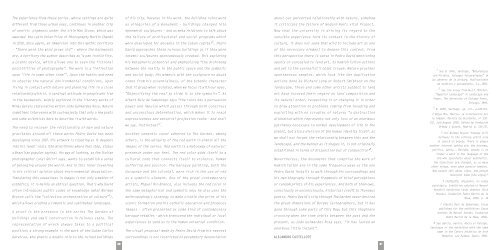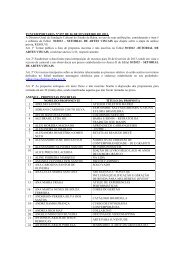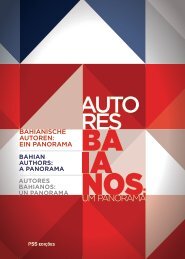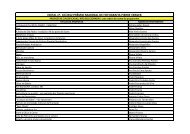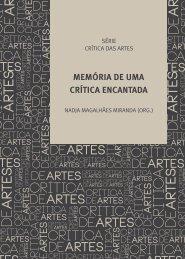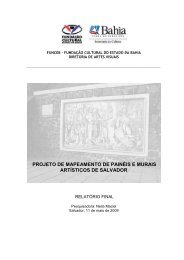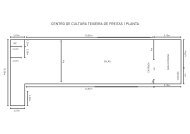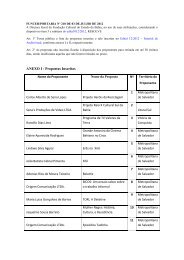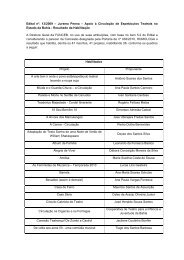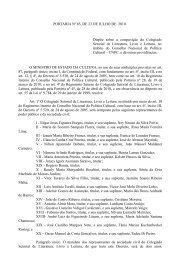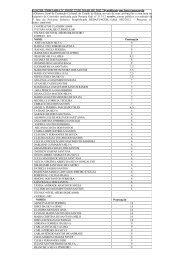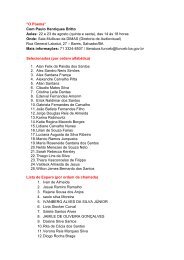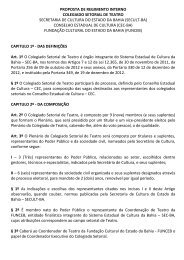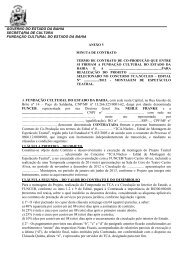Fazer download PDF - Fundação Cultural do Estado da Bahia
Fazer download PDF - Fundação Cultural do Estado da Bahia
Fazer download PDF - Fundação Cultural do Estado da Bahia
You also want an ePaper? Increase the reach of your titles
YUMPU automatically turns print PDFs into web optimized ePapers that Google loves.
The experience from these series, whose settings are quite<br />
of his city, Havana; in his work, the building ruins work<br />
about our perverted relationship with nature, somehow<br />
different from those urban ones, continues in another trip<br />
as allegories of a monument – buildings changed into<br />
it criticizes the failure of modern man’s vital Project.<br />
of oneiric pigments under the title Man Stone, which was<br />
ephemeral sculptures – and as meta relations to talk about<br />
Now that the university is driving its regard to the<br />
awarded the Latin Union Prize of Photography Martín Chambi<br />
the failure of architectural and social programs which<br />
sensible experience form its context in the history of<br />
in 2010. Once again, an immersion into this mythic territory<br />
were developed for decades in the Cuban capital 6 . Pedro<br />
culture, it <strong>do</strong>es not seem that wild to include art as one<br />
– “there were the wind grows old” – where the backwoods<br />
David approaches these ruinous buildings as if they were<br />
of the necessary element to deepen this context. From<br />
are, a territory the author describes as “a pan in mild fire,<br />
totemic sculptures spontaneously created. This exploring<br />
this perspective there is sense in Pedro David mentioning<br />
a cosmic device, which allows one to seen the fictional<br />
his metaphoric potential and emphasizing “the dichotomy<br />
openly or concealed to land art, to Hamish Fulton actions<br />
possibilities of photography”. The work is a “reflection<br />
between the reality in the public space and the symbolic<br />
and yet to the surrealist’s objet trouvé. Nature provides<br />
1 See B. Olmo, Santiago, “Naturalezas<br />
upon ‘life in some other time’”. Upon the habits and need<br />
to observe the natural environmental conditions, upon<br />
living in contact with nature and planning life in a close<br />
and social body. His mimesis with the sculpture no <strong>do</strong>ubt<br />
comes from his essentialness, of the totemic character<br />
that it grasp when isolated, when we focus it with our eyes.<br />
spontaneous samples, which look like the duplicative<br />
actions <strong>do</strong>ne by Richard Long or Robert Smithson on the<br />
landscape. These and some other artists subject to land<br />
artificiales. Paisages fotografia<strong>do</strong>s” in<br />
Los géneros de la pintura. Publicaciones<br />
de estética y pensamiento, S.L.,1994.<br />
2 See the essay from W.J.T. Mitchel,<br />
relationship with it. A cardinal attitude in people who live<br />
in the backwoods, widely explored in the literary works of<br />
Minas Gerais state native writer João Guimarães Rosa. Nature<br />
“Objectifying the real to slide it to the symbolic”. As<br />
Albert Ruiz de Samaniego says “the ruins has a persuasion<br />
power and impulse which passes through both conscious<br />
art have focused their regard on land composition and<br />
its natural order, respecting it or changing it in order<br />
to draw attention to problems coming from invading and<br />
“Imperial Landscape” in Landscape and<br />
Power. The University of Chicago Press,<br />
Chicago, 1994.<br />
3 B. OLMO, Santiago, op. cit., p.120-121.<br />
sometimes intervenes with such majesty that only a few poets<br />
and unconscious determination, which makes it to reach<br />
exploiting with no scruples of nature; “a destructive<br />
4 Rojas Mix, Marcos. La colonización por<br />
and some scientists <strong>da</strong>re to describe it with words.<br />
The need to recover the relationship of man and nature<br />
gravitates around all these works Pedro David has been<br />
developing since 1997. His artwork is ripening as it deepens<br />
into his lands’ roots (the mind thinks where feet step, states<br />
a Brazilian popular saying). His way of looking, as the Italian<br />
photographer Luigi Ghirri says, wants to establish a sense<br />
of belonging around the world. And in this inner traveling<br />
is his critical opinion about environmental devastation.<br />
Translating this uneasiness in images is not only a matter of<br />
esthetics; it is mainly an ethical question. That’s why David<br />
often introduces public codes of knowledge (what Norman<br />
Bryson calls the “collective orchestration of culture” 5 ),<br />
expressiveness and sensorial projection realm – and shall<br />
we say, instinctual” 7 .<br />
Another semantic cover adhered to The Garden, among<br />
others, is the ubiquity of the red earth in almost all the<br />
images of the series. Red earth is a metonymy of natures’<br />
presence under our feet. The red color adds itself to a<br />
cultural code that connects itself to violence, human<br />
suffering and passion. The baroque painting, both the<br />
European and the colonial, were rich in the use of red<br />
as a symbolic element. One of the great contemporary<br />
artists, Miguel Rio Branco, also includes the red color in<br />
the same metaphorical and symbolic key; he also uses the<br />
anthropophagic strategy to make visible the print of his<br />
alienation which represents not only loss of an enormous<br />
patrimony necessary to normal development of life in the<br />
planet, but also a division of the human identity itself, as<br />
we shall not forget the relationship between this and the<br />
landscape, and the manner as it shapes it, is not originally<br />
established in terms of disjunction but of conjunction” 8 .<br />
Nevertheless, the <strong>do</strong>cuments that comprise the work of<br />
Hamish Fulton are in the same frequency wave as the one<br />
Pedro David installs to walk through his surroundings and<br />
his own biography through fragments of brief perceptions<br />
or ran<strong>do</strong>m prints of his experiences. And both of them owe,<br />
consciously or unconsciously, historical credit to Thoreaus<br />
poetry. Pedro David’s trip through The Garden never desired<br />
la imagen. Revista de Occidente, nº 230-<br />
231, July-August 2000. Edited by Fun<strong>da</strong>ción<br />
Ortega y Gasset, Madrid. p. 136-137.<br />
5 For Norman Bryson “nobody still<br />
believes in the solitary artist only<br />
in search of beauty. There is always<br />
another interest behind art: the economy,<br />
politics, vanity... Besides, beauty is no<br />
longer a word in the language of the<br />
one who speculates about aesthetics.<br />
The objectives are changed, as so many<br />
other things, even when passion remains.<br />
Now people talk about signs. And people<br />
interpret them [the signs].”<br />
6 CASTELLOTE, Alejandro. Un index<br />
patológico. Exhibition catalog of Manuel<br />
Sendón’s exhibition Casas <strong>do</strong>entes (Sick<br />
Houses). Fun<strong>da</strong>ción Pedro Barrié de la<br />
Maza, 2006. p. 16<br />
which allows eluding a romantic and sublimated landscape.<br />
scenic formation and his catholic education and produces<br />
the great dimensions of Borges Cartographers, but it has<br />
7 Alberto Ruiz de Samaniego. Essay<br />
A proof is the presence in the series The Garden of<br />
buildings and small construction in ruinous state. The<br />
representation of wreck always takes to a political<br />
position; a strong example is the work of the Cuban Carlos<br />
Garaicoa, who grants a <strong>do</strong>uble role to the ruined buildings<br />
images – often presented as some kind of contemporary<br />
baroque retables – which transcend the individual or local<br />
experiences to send us to the human universal condition.<br />
The visual proposal made by Pedro David from his nearest<br />
surroundings is not restricted to peremptory denunciation<br />
gone through some parts of this Map; but this imaginary<br />
crossing when the time orbits between the past and the<br />
present, as João Guimarães Rosa says, “it has lasted an<br />
enormous little instant”.<br />
Alejandro Castellote<br />
published for the exhibitions Casas<br />
Doentes de Manuel Sendón. Fun<strong>da</strong>ción<br />
Pedro Barrié de la Maza. 2006.<br />
8 See García, Aurora. Hacia el Paisage.<br />
Catalogue of the exhibition with the same<br />
name in the Centro Altántico de Arte<br />
Moderno, Las Palmas, Spain, 1990.<br />
80 81


